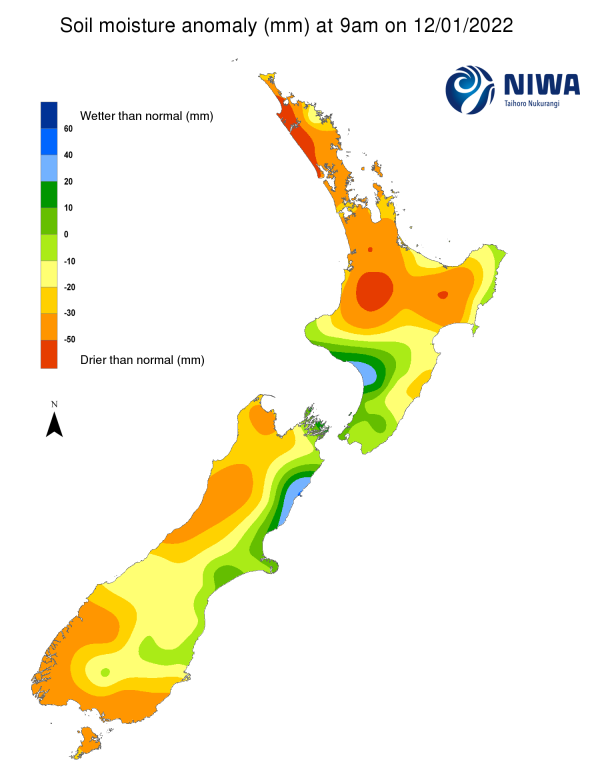A weekly update describing soil moisture patterns across the country to show where dry to extremely dry conditions are occurring or imminent. Regions experiencing significant soil moisture deficits are deemed “hotspots”. Persistent hotspot regions have the potential to develop into drought.
Facts: Soil Moisture
In the North Island, little if any rainfall (0-5 mm) has been observed in the past week across most regions, although pockets of 10-20 mm were observed in Gisborne and Hawke’s Bay due to light showers within occasional onshore wind flow. The meagre rainfall has resulted in moderate to large soil moisture decreases across the entire North Island. The driest soils across the North Island, when compared to normal for this time of the year, are found in western Northland and much of Waikato, while the wettest soils for this time of the year are found in coastal Manawatū-Whanganui.
Hotspot conditions are now located across much of the upper half of the North Island, along with most of the east coast with the exceptions of coastal Gisborne and southern Wairarapa. As of 17 January, the New Zealand Drought Index (NZDI) map shown below indicates that dry conditions are now located in Northland, Auckland, much of Waikato, western Bay of Plenty, and southern Hawke’s Bay. In addition, very dry conditions are located in much of Northland, northern Auckland, and northern Waikato.
In the South Island, many areas saw weekly rainfall totals reach 10-20 mm, mostly due to a front that moved north on 19-20 January. In addition, many areas in the West Coast received 25-50 mm. However, this resulted in additional soil moisture decreases across nearly all of the South Island. The driest soils in the South Island, when compared to normal for this time of the year, are located in the upper West Coast and Fiordland, while the wettest soils for this time of the year are found in far northern Canterbury.
Hotspots are currently located in Nelson and northeastern Tasman, along with parts of southern and interior Otago and coastal Southland. As of 17 January, the New Zealand Drought Index (NZDI) map shown below indicates that dry conditions are now located in Nelson, southern and interior Otago, eastern Southland, and Stewart Island. In addition, very dry conditions are located in eastern Southland and Stewart Island, with a new area of extremely dry conditions located east of Invercargill.
Outlook and Soil Moisture
In the North Island, showers may affect Gisborne and Hawke’s Bay on Friday (21 January), while other regions will be dry. Dry weather will continue over the weekend as high pressure sits overhead. However, tropical moisture is expected to move over the North Island from Monday to Wednesday (24-26 January). The upper half of the island could see widespread rainfall amounts near or above 50 mm, with locally higher amounts possible in Northland and Auckland. In the southern North Island, weekly totals may reach 15-30 mm.
Due to the expected rainfall in the next week, soil moisture levels may increase moderately in the upper half of the North Island, while small soil moisture increases could occur elsewhere. This would likely improve the hotspot conditions in much of the upper North Island, but it may not eliminate them completely.
In the South Island, primarily dry weather is expected to persist through to Monday (24 January) as high pressure controls the region’s weather. However, southern and eastern areas may see isolated light showers over the next few days. The aforementioned tropical moisture may reach as far south as the upper South Island during Tuesday and Wednesday (25-26 January), perhaps bringing moderate rainfall totals there. Weekly rainfall amounts of 15-30 mm may be found from Tasman to Marlborough, with 10-20 mm possible in the eastern and lower South Island. Meanwhile, only meagre amounts are expected in the West Coast.
Due to the expected rainfall in the next week, small additional soil moisture decreases could occur in most areas, with larger decreases likely in the West Coast. However, slight increases may occur in the far north. Current hotspots in the upper South Island may improve slightly in the next week, while others may see little change.
Background:
Hotspot Watch: a weekly advisory service for New Zealand media. It provides soil moisture and precipitation measurements around the country to help assess whether extremely dry conditions are imminent.
Soil moisture deficit: the amount of water needed to bring the soil moisture content back to field capacity, which is the maximum amount of water the soil can hold.
Soil moisture anomaly: the difference between the historical normal soil moisture deficit (or surplus) for a given time of year and actual soil moisture deficits.
Definitions: “Extremely” and “severely” dry soils are based on a combination of the current soil moisture status and the difference from normal soil moisture (see soil moisture maps at https://www.niwa.co.nz/climate/nz-drought-monitor/droughtindicatormaps)
Hotspot: A hotspot is declared if soils are "severely drier than normal" which occurs when Soil Moisture Deficit (SMD) is less than -110 mm AND the Soil Moisture Anomaly is less than -20 mm.
Pictured above: Soil Moisture Anomaly Maps, relative to this time of year. The maps show soil moisture anomaly for the past two weeks.
New Zealand Drought Index (NZDI)
As of 17 January, the New Zealand Drought Index (NZDI) map below shows that dry conditions are now located in Northland, Auckland, much of Waikato, western Bay of Plenty, southern Hawke’s Bay, Nelson, southern and interior Otago, eastern Southland, and Stewart Island. In addition, very dry conditions are located in much of Northland, northern Auckland, northern Waikato, eastern Southland and Stewart Island, with a new area of extremely dry conditions located east of Invercargill. Please note: some hotspots in the text above may not correspond with the NZDI map. This difference exists because the NZDI uses additional dryness indices, including one which integrates the rainfall deficit over the past 60 days. Changes are therefore slower to appear in the NZDI compared to soil moisture anomaly maps that are instantaneously updated.




